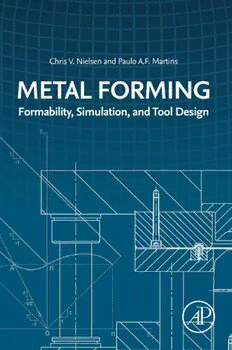Table Of ContentMETAL FORMING
METAL FORMING
Formability, Simulation,
and Tool Design
CHRIS V. NIELSEN
Technical University of Denmark, Lyngby,Denmark
PAULO A.F. MARTINS
IDMEC,Instituto SuperiorTécnico, University of Lisbon,
Portugal
AcademicPressisanimprintofElsevier
125LondonWall,LondonEC2Y5AS,UnitedKingdom
525BStreet,Suite1650,SanDiego,CA92101,UnitedStates
50HampshireStreet,5thFloor,Cambridge,MA02139,UnitedStates
TheBoulevard,LangfordLane,Kidlington,OxfordOX51GB,UnitedKingdom
©2021ElsevierInc.Allrightsreserved.
Nopartofthispublicationmaybereproducedortransmittedinanyformorbyanymeans,electronic
ormechanical,includingphotocopying,recording,oranyinformationstorageandretrievalsystem,
withoutpermissioninwritingfromthepublisher.Detailsonhowtoseekpermission,further
informationaboutthePublisher’spermissionspoliciesandourarrangementswithorganizationssuch
astheCopyrightClearanceCenterandtheCopyrightLicensingAgency,canbefoundatourwebsite:
www.elsevier.com/permissions.
Thisbookandtheindividualcontributionscontainedinitareprotectedundercopyrightbythe
Publisher(otherthanasmaybenotedherein).
Notices
Knowledgeandbestpracticeinthisfieldareconstantlychanging.Asnewresearchandexperience
broadenourunderstanding,changesinresearchmethods,professionalpractices,ormedical
treatmentmaybecomenecessary.
Practitionersandresearchersmustalwaysrelyontheirownexperienceandknowledgeinevaluating
andusinganyinformation,methods,compounds,orexperimentsdescribedherein.Inusingsuch
informationormethodstheyshouldbemindfuloftheirownsafetyandthesafetyofothers,including
partiesforwhomtheyhaveaprofessionalresponsibility.
Tothefullestextentofthelaw,neitherthePublishernortheauthors,contributors,oreditors,assume
anyliabilityforanyinjuryand/ordamagetopersonsorpropertyasamatterofproductsliability,
negligenceorotherwise,orfromanyuseoroperationofanymethods,products,instructions,orideas
containedinthematerialherein.
LibraryofCongressCataloging-in-PublicationData
AcatalogrecordforthisbookisavailablefromtheLibraryofCongress
BritishLibraryCataloguing-in-PublicationData
AcataloguerecordforthisbookisavailablefromtheBritishLibrary
ISBN978-0-323-85255-5
ForinformationonallAcademicPresspublications
visitourwebsiteathttps://www.elsevier.com/books-and-journals
Publisher:MatthewDeans
AcquisitionsEditor:DennisMcGonagle
EditorialProjectManager:CharlotteRowley
ProductionProjectManager:PoulouseJoseph
CoverDesigner:ChristianBilbow
TypesetbySPiGlobal,India
To our families.
Contributors
BrianN.Legarth
TechnicalUniversityofDenmark,Lyngby,Denmark
(Chapter5)
LuisM.Alves
InstitutoSuperiorT(cid:1)ecnico,UniversityofLisbon,Lisbon,Portugal
(Chapter6)
MariaBeatrizSilva
InstitutoSuperiorT(cid:1)ecnico,UniversityofLisbon,Lisbon,Portugal
(Chapter2)
NielsBay
TechnicalUniversityofDenmark,Lyngby,Denmark
(Chapter6)
xi
Preface
The present book is intended as an advanced textbook on metal forming,
which aims at bridging the gap between standard BSc and MSc teaching
and advanced research topics focusing on three main topics:
(i)formability,(ii)finiteelementmodellingand(iii)tooldesign.Theobjec-
tivesareasfollows:firstly,toprovideessentialknowledgeonformabilityand
finiteelementtopics,whichstudentsandengineersuseintheirdailyactiv-
ities, sometimes without fully understanding the theoretical background;
secondly, to give readers, who have attended basic metal forming courses
to be able to understand some of the topics that are currently dealt with
inadvancedresearchonmetalforming;andfinally,toprovideyoungengi-
neers taking the first steps in advanced tool design and sizing, a gateway to
the industry.
Theintroductorychapter(Chapter1)givesabroaderdescriptionofthe
scopeof thebookandends with aclassification of metalformingprocesses
based on their load/deformation pattern according to the German DIN
standard.
Chapter2isdedicatedtothemechanismsoffractureandplasticinstabil-
ity.Themostcommonlyappliedphenomenologicalmodelsofductiledam-
ageandfracturebasedoncontinuummechanicsarepresented.Thesecond
partofChapter2isdedicatedtoplasticinstabilitypresentingtheclassicthe-
ory by Swift as well as Marciniak-Kuczynski theory for instability in sheet
forming.Afinalpartdescribestypicalmaterialflowdefectsinbulkandsheet
metal forming.
Chapter 3 presents a user’s perspective on finite element modelling of
metal forming processes providing information about accuracy, reliability
and validity. A number of simple examples are given, which illustrates
theprosandconsofthedifferentformulations(flowformulation,solidfor-
mulation and dynamic formulation). The chapter is very useful to users of
commercial codes with little knowledge about finite element modelling.
Chapter4providesdeeperknowledgeonfiniteelementanalysisofmetal
formingexemplifiedbytheflowformulation,inwhichthetwoauthorshave
long-term expertise. Throughout the chapter, some very useful, simple
examples illustrate the numerical issues and their solutions.
Chapter5providesintroductoryknowledgeonthefiniteelementsolid
formulationappliedtometalformingbydiscretisationandimplementation
xiii
xiv Preface
of the finite element equations for an elastic-viscoplastic material model. It
opens the way for readers, who want to progress to more sophisticated
implementations of the solid formulation.
Chapter 6 provides a comprehensive description of tool design. The
chapter gives examples on tools, design guidelines including dimensioning
as well as information on tool materials and lubricants.
Thereareseveralbookscoveringthefundamentalsonmetalformingat
BSc and MSc levels and a significant number of books covering specific
research topics of metal forming. The present book aims at bridging the
gap between these two types of books.
Niels Bay
Emeritus Professor
Technical University of Denmark, Lyngby,
Denmark
Acknowledgements
This book would never have been written without the collaboration and
supportofseveralpeople,companiesandinstitutions.Westartbythanking
our coauthors Beatriz Silva, Brian Legarth, Luis Alves and Niels Bay, who
generously contributed with their knowledge to several chapters of this
book. Niels Bay is further acknowledged for his long-time scientific and
technical mentoring of the authors.
TonyAkins,whodiedin2018,isalsorememberedforhisinspirational
vision on the interaction between formability and fracture mechanics.
Erman Tekkaya has been sharing high-quality teaching material and
knowledge with Paulo Martins for a long time. This was an important
and inspiring source of information for some of the chapters included in
this book.
The support of Klaus Schreiner from Hatebur, Viktor Lazorkin from
Lazorkin Engineering and Motonobu Furuya from NICHIDAI Corpora-
tion, and of their companies to the tool design chapter is greatly acknowl-
edged. Similar acknowledgements go to the permissions given by the
editorial company Casteilla.
TheEnglishlanguagerevisionofthechaptersinthisbookbyTomand
Jan Goodwin is also greatly acknowledged by the authors.
The authors also want to thank Dennis McGonagle for believing and
supporting the authors’ book proposal and Poulouse Joseph for the great
help provided during the preparation of this book.
ThesupportoftheTechnicalUniversityofDenmark,InstitutoSuperior
T(cid:1)ecnicoattheUniversityofLisbon,Fundac¸a˜oparaaCi^enciaeaTecnologia
of Portugal and IDMEC under LAETA-UIDB/50022/2020 and PTDC/
EME-EME/0949/2020 is also acknowledged.
Finally,wewouldliketothankourfamiliesforthesupportandencour-
agement they gave us during the writing of this book.
Chris V. Nielsen
Paulo A.F. Martins
xv
CHAPTER 1
Introduction*
Students attending metal forming courses are exposed to a wide range of
topicscoveringplasticitytheory,analyticalandnumericalmethodsofanal-
ysis,materialscience,formabilityandfracture,frictionandlubrication,pro-
cesses and machine tools, and tool design. However, the type of exposure
varies from university to university. In general, it can be said, with due
exceptions,thatthehighertheintensitylevelinplasticity,methodsofanal-
ysis,andformabilityandfracture,thelowertheintensitylevelanddepthin
processes, machine tools, and tool design. The vice versa is equally true.
Electiveadvancedcoursesinmetalformingaremoredifficulttocharac-
terisebecausetheyareoftendesignedintheimageoftheprofessorswhoare
responsible for them, namely on their research expertise. Although this
situation may in some cases solve the low-intensity levels of exposure that
studentsmay have had to sometopicsof metalforming intheir mandatory
BSc or MSc courses, it may in other cases further deepen the differences
between the levels of exposure to different topics.
Thisbookdoesnotaimtosolvealltheseproblemsnortoprovidereaders
withauniformlevelofknowledgeinalltheaforementionedtopicsofmetal
forming.However,itpicksthreemajorkeytopicsinmetalforming,which
areoftennottaughtwiththesamelevelofintensity:(i)formability,(ii)finite
elementmodelling,and(iii)tooldesign,inordertoprovidereaderswithan
integrated,highlevelofexposuretotheoretical,experimental,anddesign-
related subjects.
Takingtheseobjectivesintoaccount,thisbookstartswithachapteron
formabilityinmetalforming(seeChapter2).Incontrasttoothertextbooks
ofmetalforming,thechapterstartswithfractureandendswithplasticinsta-
bilityandneckingbecausethelatterisnotcriticalinallmetalformingpro-
cesses.Thepresentationdrawsfromnucleation,growth,andcoalescenceof
voids, to the characterisation of different crack opening modes in terms of
plastic flow, microstructural damage and fractography. The role played by
* ChrisV.Nielsen(TechnicalUniversityofDenmark,Lyngby,Denmark)andPauloA.F.
Martins(IDMEC,InstitutoSuperiorT(cid:1)ecnico,UniversityofLisbon,Portugal).
MetalForming ©2021ElsevierInc.
https://doi.org/10.1016/B978-0-323-85255-5.00010-8 Allrightsreserved. 1

